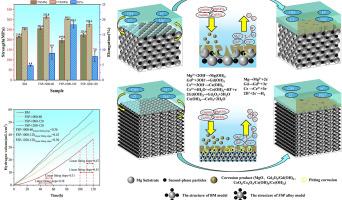通过织构和第二相的协同调节,提高搅拌摩擦处理Mg-14Gd-0.6Ce-0.5Zr合金的力学性能和长期耐腐蚀性
IF 13.8
1区 材料科学
Q1 METALLURGY & METALLURGICAL ENGINEERING
引用次数: 0
摘要
本研究采用搅拌摩擦法(FSP)对铸态Mg-14Gd-0.6Ce-0.5Zr合金进行改性,系统研究了织构演化和第二相分布对合金力学性能的影响。结果表明:搅拌摩擦处理有效地将Mg5Gd粗相细化为沿晶界均匀分布的纳米级第二相;织构弱化和第二相细化的协同作用显著提高了FSP-1000-120合金的抗拉强度和伸长率,分别达到302.1 MPa和18.3%,比铸态合金提高了20.8%和281.3%。铸态合金由于微电偶腐蚀部位较少,初期腐蚀速率较低。然而,第二相在fsp处理(FSPed)合金中的均匀分布有助于形成更完整和致密的腐蚀产物膜。浸泡120 h后,铸态合金在第二相-基体界面处持续溶解形成深坑,平均腐蚀速率从0.31 mL/cm2/h增加到0.47 mL/cm2/h。FSP-1000-60、FSP-1000-120和FSP-1200-120样品的长期腐蚀速率分别稳定在0.36、0.43和0.50 mL/cm2/h。研究表明,FSP调节织构和第二相分布,实现合金强度塑性的协同增强,第二相分布的均匀化是提高合金长期耐蚀性的关键因素。本文章由计算机程序翻译,如有差异,请以英文原文为准。

Synergistic regulation of texture and second phases to enhance the mechanical properties and long-term corrosion resistance of friction stir processed Mg-14Gd-0.6Ce-0.5Zr alloy
In this study, friction stir processing (FSP) was employed to modify the as-cast Mg-14Gd-0.6Ce-0.5Zr alloy, and the effects of texture evolution and distribution of second phases on mechanical properties were systematically investigated. The results show that friction stir processing effectively refined the coarse Mg5Gd phases into nanoscale second phases uniformly distributed along grain boundaries. The synergistic effect of texture weakening and second phases refinement significantly enhanced the tensile strength and elongation of the FSP-1000-120 alloy to 302.1 MPa and 18.3%, respectively, representing increases of 20.8% and 281.3% compared to the as-cast alloy. The as-cast alloy has a lower corrosion rate in the initial stage due to fewer micro-galvanic corrosion sites. However, the uniform distribution of the second phase in the FSP-treated (FSPed) alloy contributes to the formation of a more complete and dense corrosion product film. After 120 h of immersion, the as-cast alloy forms deep pits due to the continuous dissolution at the second phase-matrix interface, with the average corrosion rate increasing from 0.31 to 0.47 mL/cm2/h. The long-term corrosion rates of FSP-1000-60, FSP-1000-120, and FSP-1200-120 samples are stable at 0.36, 0.43, and 0.50 mL/cm2/h, respectively. Research reveals that FSP regulates texture and second phase distribution to achieve synergistic strengthening of alloy strength plasticity, and the homogenization of second phase distribution is a key factor in improving the long-term corrosion resistance of alloys.
求助全文
通过发布文献求助,成功后即可免费获取论文全文。
去求助
来源期刊

Journal of Magnesium and Alloys
Engineering-Mechanics of Materials
CiteScore
20.20
自引率
14.80%
发文量
52
审稿时长
59 days
期刊介绍:
The Journal of Magnesium and Alloys serves as a global platform for both theoretical and experimental studies in magnesium science and engineering. It welcomes submissions investigating various scientific and engineering factors impacting the metallurgy, processing, microstructure, properties, and applications of magnesium and alloys. The journal covers all aspects of magnesium and alloy research, including raw materials, alloy casting, extrusion and deformation, corrosion and surface treatment, joining and machining, simulation and modeling, microstructure evolution and mechanical properties, new alloy development, magnesium-based composites, bio-materials and energy materials, applications, and recycling.
 求助内容:
求助内容: 应助结果提醒方式:
应助结果提醒方式:


